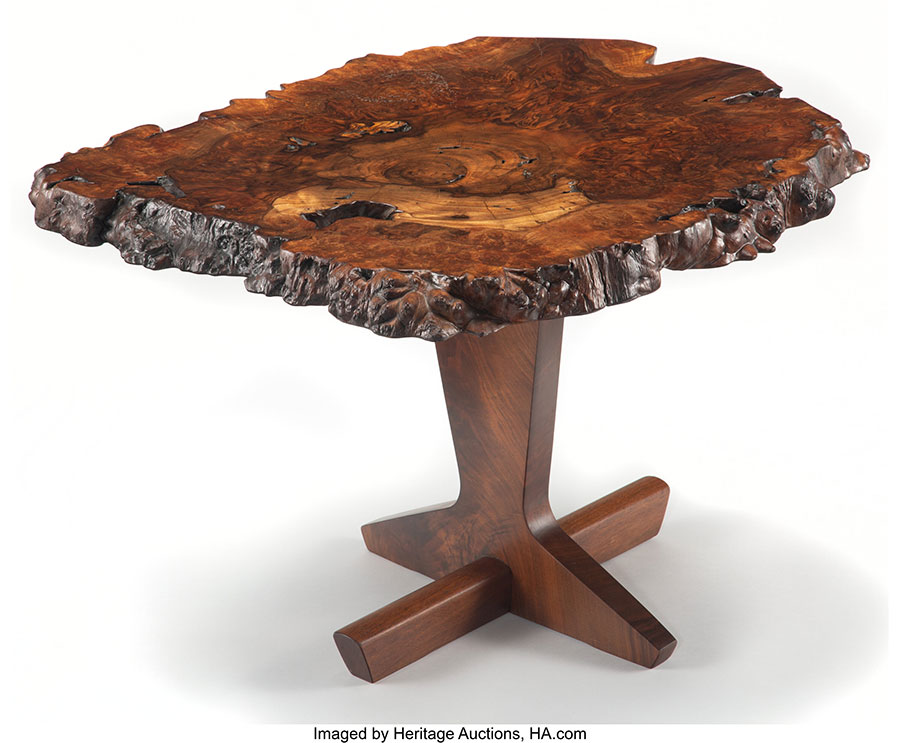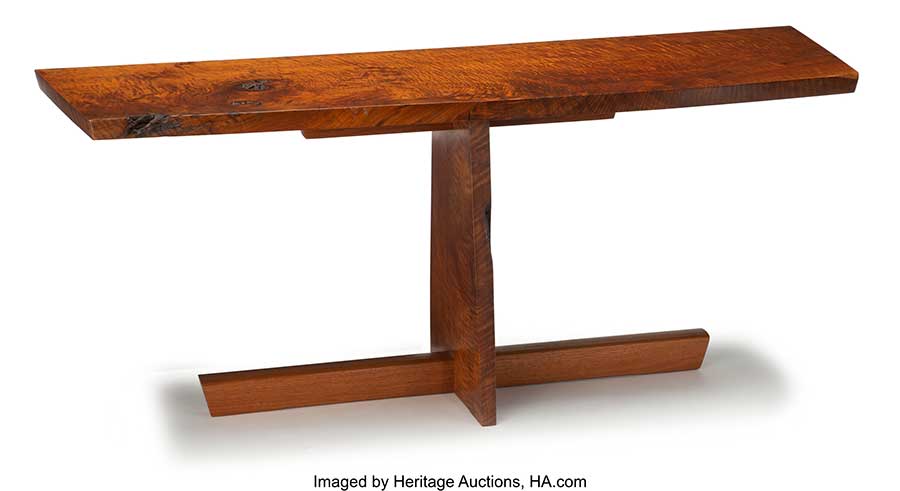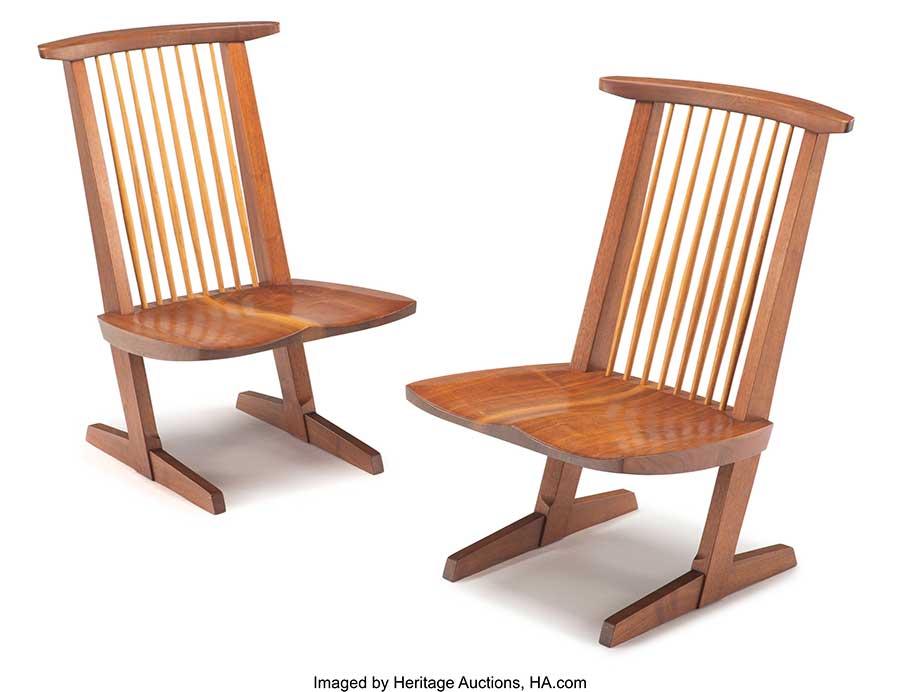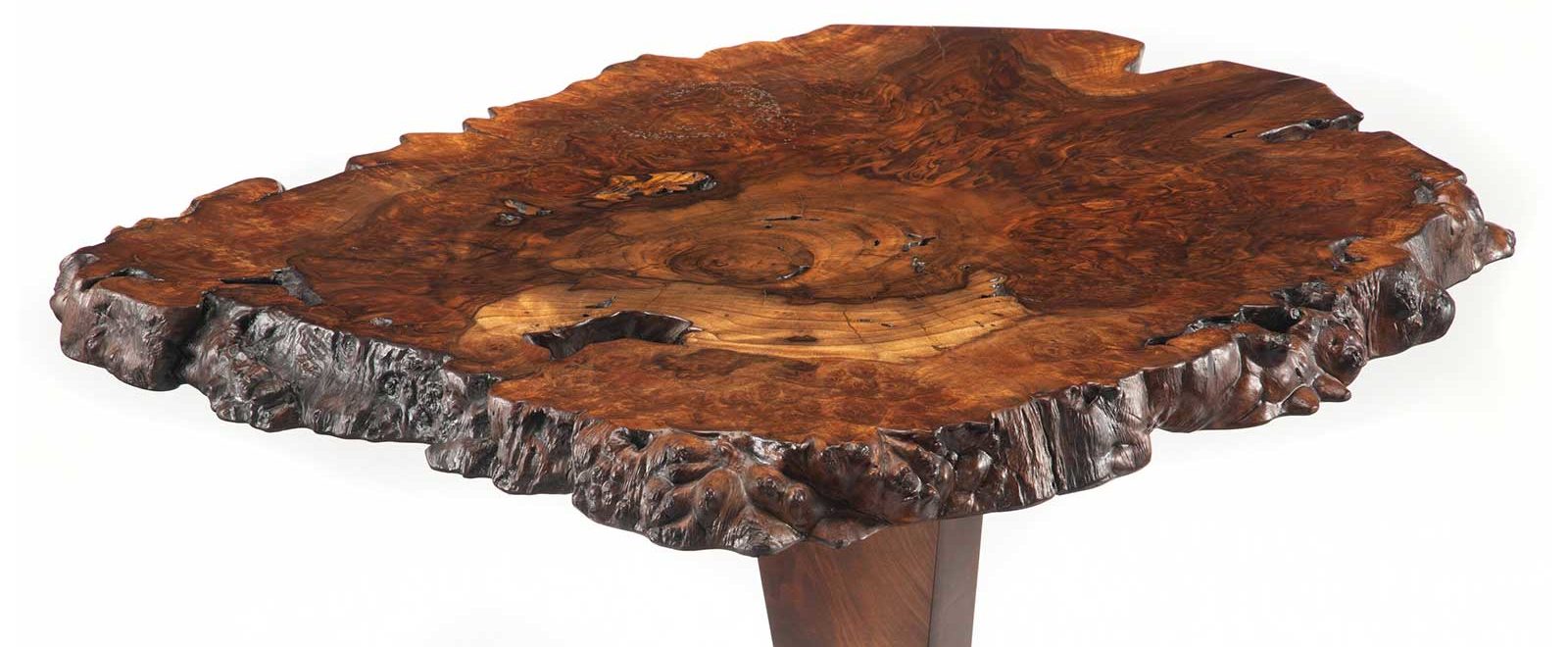EXPLORING THE SIGNATURE MOVES OF THE CELEBRATED AMERICAN FURNITURE MAKER
By Rhonda Reinhart
EVENT
DESIGN SIGNATURE® AUCTION 8074
Jan. 27, 2022
Online: HA.com/8074a
INQUIRIES
Brent Lewis
310.492.8665
BrentL@HA.com
Though most of his pieces are one of a kind, all of George Nakashima’s furniture designs have something in common: a never-wavering reverence for the wood used to create them. Born in Washington state in 1905 to Japanese immigrant parents, the future master woodworker was an Eagle Scout who fell in love with nature while exploring the forests of the Pacific Northwest.
He studied forestry and architecture at the University of Washington and received a master’s degree in architecture from MIT. In 1934, he joined Antonin Raymond’s architecture firm in Tokyo, where he developed a deep appreciation for Japanese culture and design. While working for the firm, he also spent time in India, overseeing the construction of a major dormitory building at an ashram, where he studied Integral Yoga and became a disciple of the guru Sri Aurobindo. Nakashima’s time in India had a profound effect on his personal and professional life, and it’s where he created some of his first pieces of furniture.
Enlarge

In 1941, after marrying Seattle native Marion Okajima, Nakashima moved to Seattle and redirected his focus from architecture to furniture. Just one year later, however, the couple and their infant daughter were forced into an internment camp in Idaho. While at the camp, Nakashima met and studied with master Japanese carpenter Gentaro Hikogawa, who greatly influenced Nakashima’s future work. In 1943, Raymond, Nakashima’s former employer, secured the family’s release from the internment camp by giving Nakashima a job on his farm in New Hope, Pennsylvania, where Nakashima would go on to open his furniture workshop in 1945.
Nakashima died in 1990 at the age of 85, but his legacy lives on, as does his studio, now led by his daughter, Mira Nakashima. As president of George Nakashima Woodworkers, Mira is dedicated to preserving her father’s creative vision. “We try to do everything the way Dad did,” she has said. “And when we get stuck, we think: What would George do?”
Today, Nakashima designs are prized among collectors. Last spring, Heritage Auctions sold a rare 1984 Odakyu table by Nakashima for $57,500, and on Jan. 27, in its Design Signature® event, the auction house will offer eight sought-after Nakashima pieces dating from the early 1940s to the early 1980s. Among the offerings is a rare Kornblut cabinet from one of Nakashima’s most important commissions. Completed in 1980 for International Paper’s New York headquarters, the special cabinet, a unique version of an iconic Nakashima design, has been off the market for more than 15 years.
Whether they were created in 1941 or 2021, every Nakashima Woodworkers piece exhibits the same signature features the studio founder developed eight decades ago: “George Nakashima’s work – and that made under the care of his daughter, Mira – represents more than its functionality and aesthetic beauty,” says Brent Lewis, Heritage Auctions’ Director of Design. “Nakashima furniture signifies a particular approach to life, of appreciating nature and preserving thoughtfulness in one’s work.”
Enlarge

LETTING NATURE LIVE ON
In Nakashima’s view, using wood to create furniture was a way of giving a tree a second life, a philosophy he detailed in his 1983 memoir The Soul of a Tree, in which he described wood not as an inanimate object, but as a material that “lives and breathes.” Nakashima also treasured what many others might consider debris, collecting wood from land-clearing and other instances of tree removal. In his hands, these discards would become beautiful – and useful – creations, admired for their artistry and elite craftsmanship. “Cutting logs entails a great responsibility, for we are dealing with fallen majesty,” he wrote. “There are no formulas, no guidelines, but only experience, instinct and contact with the divine.” Today, the Nakashima studio still custom-mills sustainably harvested hardwoods.
Enlarge

CELEBRATING SIMPLICITY
Inspired by both Japanese and early American woodworking traditions, Nakashima created minimalist masterpieces with pure lines and simple forms. Known for his spare use of materials, he eschewed ornamentation in his designs, instead focusing on functionality. Though Nakashima occasionally collaborated with companies such as Knoll and Widdicomb-Mueller, he preferred to produce hand-crafted pieces. “Even when he was alive, we were working against the modern ethos of technology and mass production and trying to make as much money as possible,” Mira Nakashima said in August 2021, during a virtual tour of the Nakashima studio. “It was more important for him to make something of quality than it was to make something to make a lot of money.”
Enlarge

EMBRACING THE PERFECTLY IMPERFECT
Instead of hiding flaws in wood, Nakashima honored them, often leaving the unfinished, natural edges on a slab rather than trimming them off. This “free-edge” approach resulted in unique creations that celebrated the individuality of every piece of wood. Nakashima also used butterfly joints to reinforce cracks in the wood, and he made sure to showcase each slab’s distinct grain, as well as its burls – the abnormal, rounded growths on the trunk or branch of a tree. “Instead of a long-running and bloody battle with nature to dominate her,” he wrote, “we can walk in step with a tree to release the joy in her grains, to join with her to realize her potentials, to enhance the environments of man.”
 RHONDA REINHART is editor of Intelligent Collector.
RHONDA REINHART is editor of Intelligent Collector.

